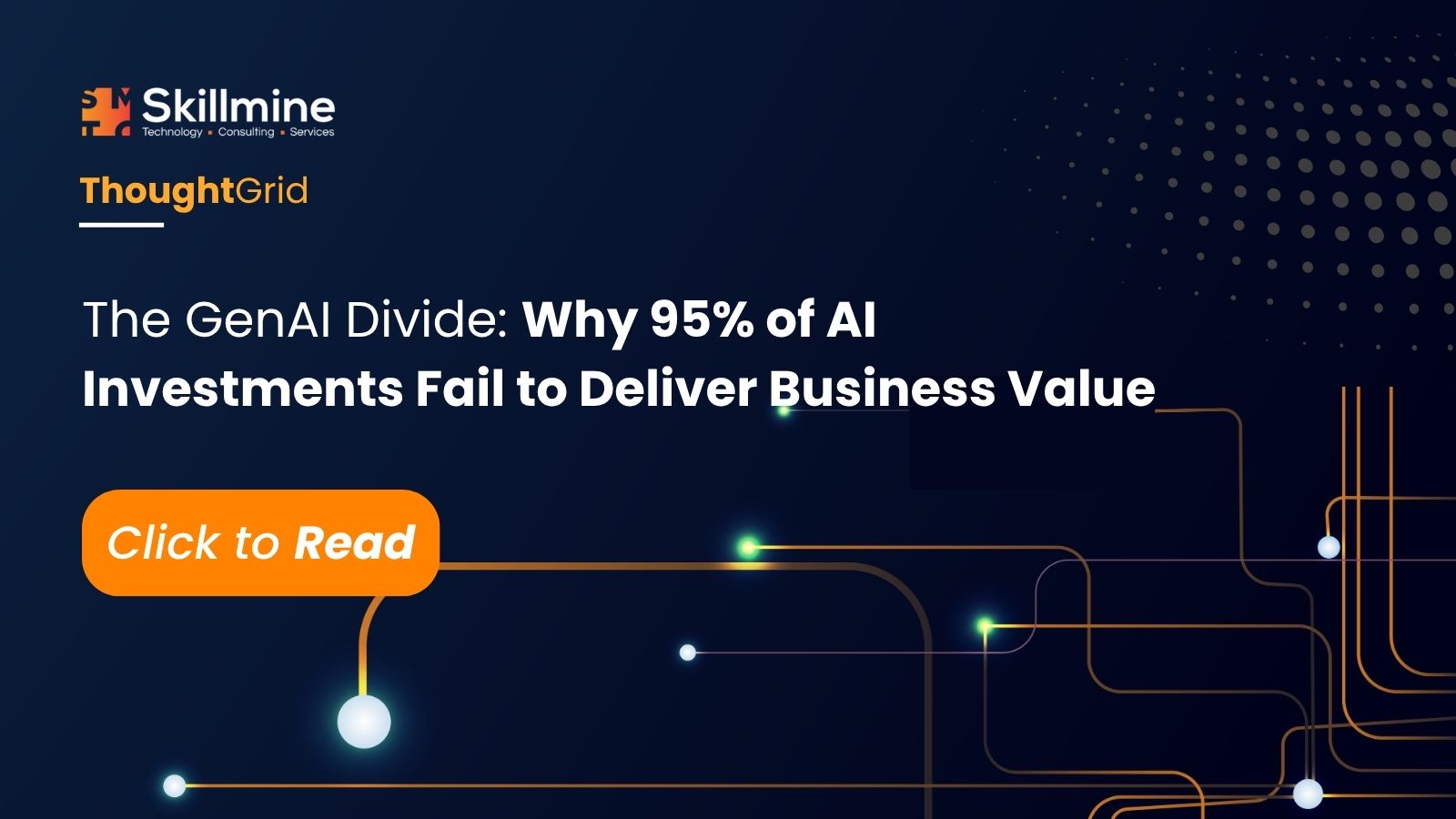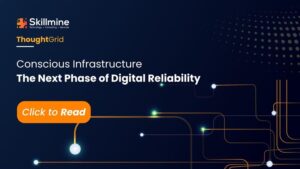Billions Spent, Minimal Return
Enterprises worldwide have already spent $30–40 billion on Generative AI. Yet, a recent MIT-led study reveals that 95% of these investments deliver zero measurable return.
These statistics may sound alarming, but for many business leaders, they are not surprising. AI dominates boardroom discussions; pilots run across departments, yet the bottom line rarely moves. The challenge isn’t hyped versus reality; it’s the GenAI Divide: the gap between experimenting with AI and actually transforming business.
These statistics may sound alarming, but for many business leaders, they are not surprising. AI dominates boardroom discussions; pilots run across departments, yet the bottom line rarely moves. The challenge isn’t hyped versus reality; it’s the GenAI Divide: the gap between experimenting with AI and actually transforming business.
High Adoption, Low Impact
On the surface, adoption seems impressive. Over 80% of organizations have piloted GenAI tools, and solutions like ChatGPT, Copilot, and others have entered workplaces at scale. Employees use them daily for drafting, research, and analysis. Enterprises are running pilots across sales, marketing, and customer service.
Yet adoption does not equal transformation:
The paradox: AI is everywhere, but real impact is rare.
The critical question: If everyone is experimenting, why is almost no one truly transforming?
Yet adoption does not equal transformation:
- Only 5% of pilots scale into production with measurable ROI.
- Out of nine industries studied, only Technology and Media show structural change.
- Large enterprises run the most pilots, yet mid-market firms scale faster and more effectively.
The paradox: AI is everywhere, but real impact is rare.
The critical question: If everyone is experimenting, why is almost no one truly transforming?

The Learning Gap
The MIT study and other research highlight a key issue: the learning gap. Most enterprise AI tools are static. They do not retain context, learn from user feedback, or adapt to evolving workflows. A tool that drafts a contract today will repeat the same mistakes tomorrow.
Employees sense this intuitively. Many quietly prefer personal ChatGPT or Claude subscriptions over sanctioned enterprise AI tools. This shadow of the AI economy shows that while individuals leverage adaptive AI daily, organizations remain stuck on the wrong side of the divide.
For enterprises, this is not just a technical problem; it is a trust gap. AI systems must learn, remember, and evolve within the business context to deliver lasting value.
Employees sense this intuitively. Many quietly prefer personal ChatGPT or Claude subscriptions over sanctioned enterprise AI tools. This shadow of the AI economy shows that while individuals leverage adaptive AI daily, organizations remain stuck on the wrong side of the divide.
For enterprises, this is not just a technical problem; it is a trust gap. AI systems must learn, remember, and evolve within the business context to deliver lasting value.
Why Enterprises Get It Wrong
Based on the MIT study and industry insights, five recurring patterns explain why most AI initiatives stall:
- Investment Bias – 70% of budgets flow to Sales & Marketing, where results are visible but often superficial. Back-office automation, finance, procurement, operations, remains underfunded despite clearer ROI potential.
- Enterprise Paradox – Large organizations pilot more but scale less. Bureaucracy and legacy systems slow true transformation.
- Pilot Purgatory – Demos impress; pilots start fast, but integration complexities halt progress before production.
- Internal Build Trap – In-house AI projects fail twice as often as external partnerships. Enterprises underestimate the effort required to build adaptive systems from scratch.
- Workflow Misfit – AI is often added as a “bolt-on” rather than embedded where business decisions happen.
The Playbook for Crossing the Divide
Successful organizations do not treat AI as a side project. They follow disciplined strategies that consistently drive value:
1. Start Narrow, Prove Value, Then Scale
Begin with a tightly scoped workflow where ROI is visible. Example: An oil & gas company starts with AI models predicting optimal crude oil blends—a single high-value use case before expanding into logistics or downstream optimization.
2. Embed AI into Core Operations True gains come when AI powers operational backbones. Manufacturers and utilities deploy digital twins of plants and grids to simulate breakdowns, optimize maintenance schedules, and improve uptime and costs.
3. Focus on Systems That Learn
AI must improve with every use. Adaptive models outperform static dashboards because they refine themselves with real-time data. Example: BFSI firms use self-learning price-prediction and demand-forecasting models to make sharper decisions amid volatile markets.
4. Tie AI Directly to Customer Outcomes AI gains credibility when it improves measurable customer metrics—reduced churn, faster resolution, higher satisfaction. Leading banks and telecoms deploy AI agents that authenticate customers, resolve queries, and close cases end-to-end.
5. Look Beyond the Obvious ROI
High ROI often hides in the background. Public sector organizations and BFSI enterprises use AI to detect procurement anomalies, mitigate fraud, and automate compliance checks, saving millions while strengthening governance.
1. Start Narrow, Prove Value, Then Scale
Begin with a tightly scoped workflow where ROI is visible. Example: An oil & gas company starts with AI models predicting optimal crude oil blends—a single high-value use case before expanding into logistics or downstream optimization.
2. Embed AI into Core Operations True gains come when AI powers operational backbones. Manufacturers and utilities deploy digital twins of plants and grids to simulate breakdowns, optimize maintenance schedules, and improve uptime and costs.
3. Focus on Systems That Learn
AI must improve with every use. Adaptive models outperform static dashboards because they refine themselves with real-time data. Example: BFSI firms use self-learning price-prediction and demand-forecasting models to make sharper decisions amid volatile markets.
4. Tie AI Directly to Customer Outcomes AI gains credibility when it improves measurable customer metrics—reduced churn, faster resolution, higher satisfaction. Leading banks and telecoms deploy AI agents that authenticate customers, resolve queries, and close cases end-to-end.
5. Look Beyond the Obvious ROI
High ROI often hides in the background. Public sector organizations and BFSI enterprises use AI to detect procurement anomalies, mitigate fraud, and automate compliance checks, saving millions while strengthening governance.

The Rise of Agentic AI
The next chapter of enterprise AI is agentic systems, AI that does not just generate content but acts, learns, and collaborates.
These systems:
Examples:
These systems:
- Coordinate across applications
- Automate multi-step workflows
- Negotiate and optimize decisions dynamically
Examples:
- Customer service agents resolving end-to-end inquiries autonomously
- Financial agents monitoring and approving routine transactions
- Sales agents tracking engagement and optimizing conversion across channels
A Broader Reflection
There is no one-size-fits-all AI strategy. What works for an oil & gas enterprise may not suit a bank or telecom. However, one truth remains: AI must serve business goals, not the other way around.
Implementing AI is not a challenge. Implementing it where it matters most and where it endures is the challenge.
Enterprises that succeed in crossing the GenAI Divide:
Implementing AI is not a challenge. Implementing it where it matters most and where it endures is the challenge.
Enterprises that succeed in crossing the GenAI Divide:
- Choose the right problems
- Embed AI into the right workflows
- Focus on outcomes that deliver sustainable business value
The Skillmine Perspective
The GenAI Divide is widening, but it can be closed.
At Skillmine, we help enterprises move beyond experimentation by embedding adaptive, learning AI systems into operational fabric. The future belongs to systems that learn, remember, and act autonomously, delivering measurable transformation, not just automation.
Ready to bridge your enterprise’s GenAI Divide? Explore how Skillmine’s AI and automation solutions can translate innovation into impact.
At Skillmine, we help enterprises move beyond experimentation by embedding adaptive, learning AI systems into operational fabric. The future belongs to systems that learn, remember, and act autonomously, delivering measurable transformation, not just automation.
Ready to bridge your enterprise’s GenAI Divide? Explore how Skillmine’s AI and automation solutions can translate innovation into impact.





